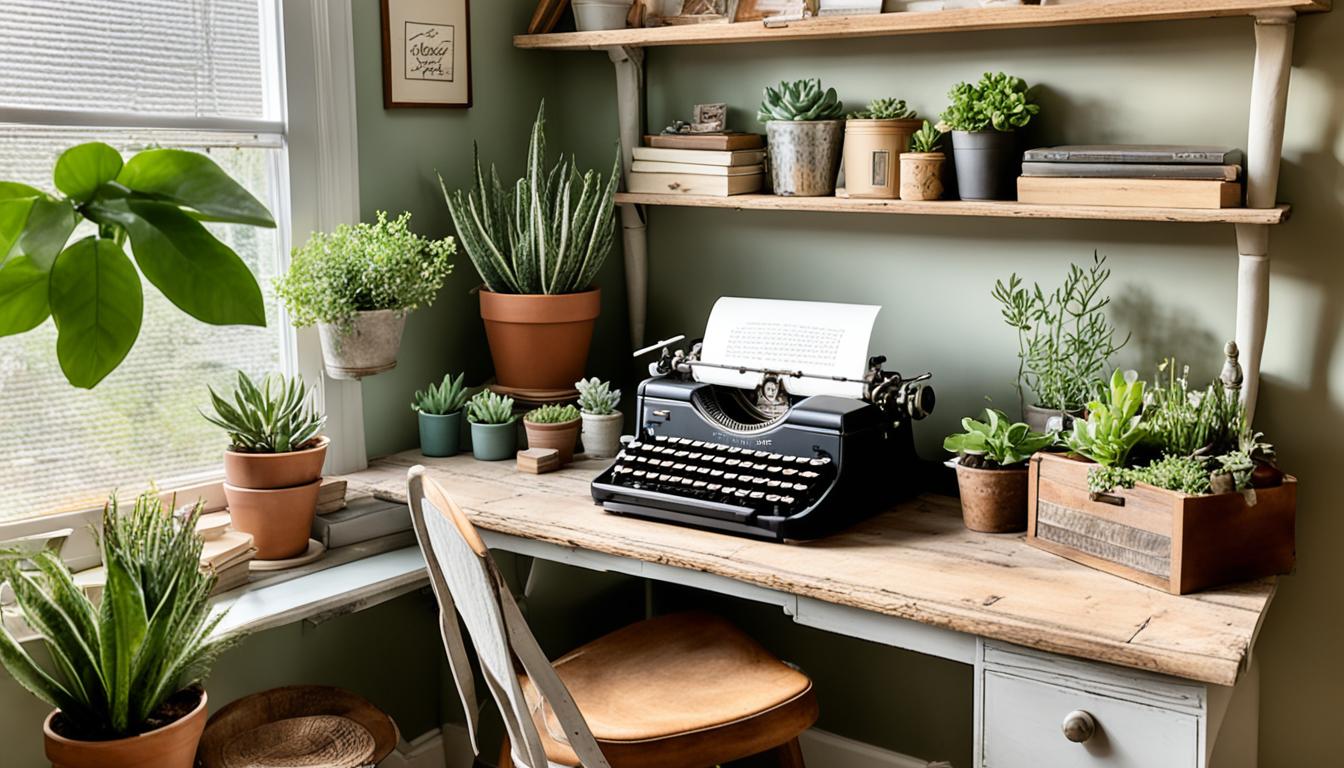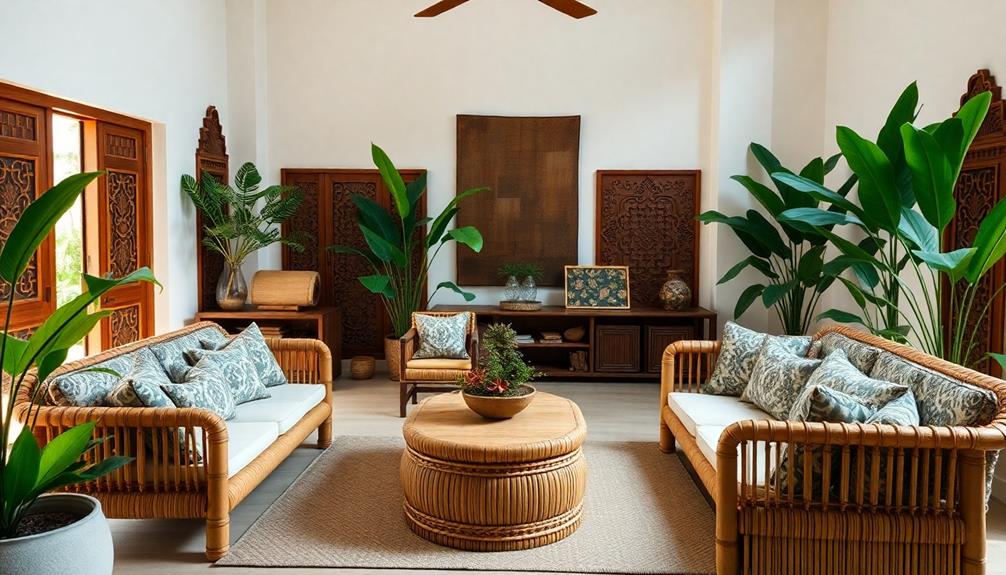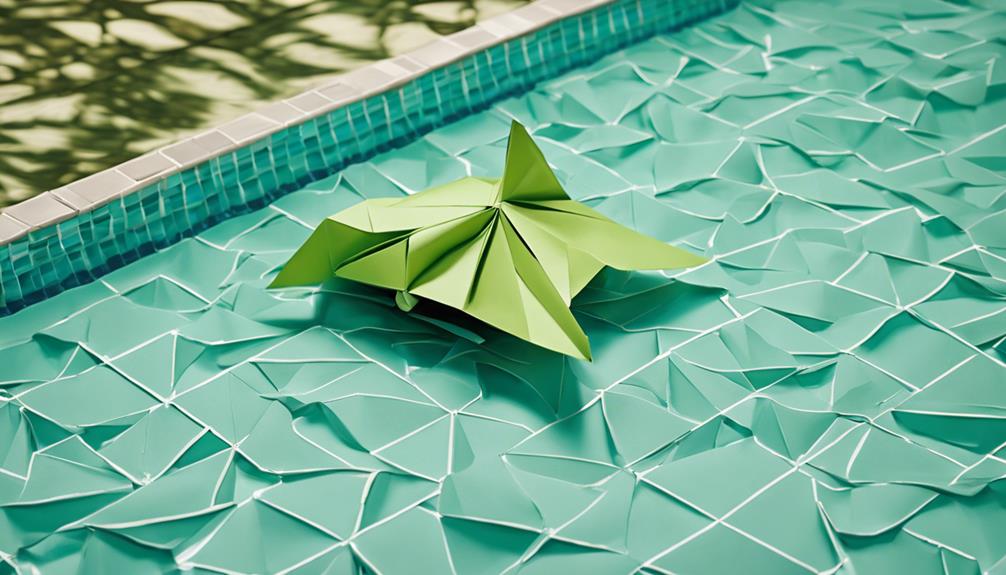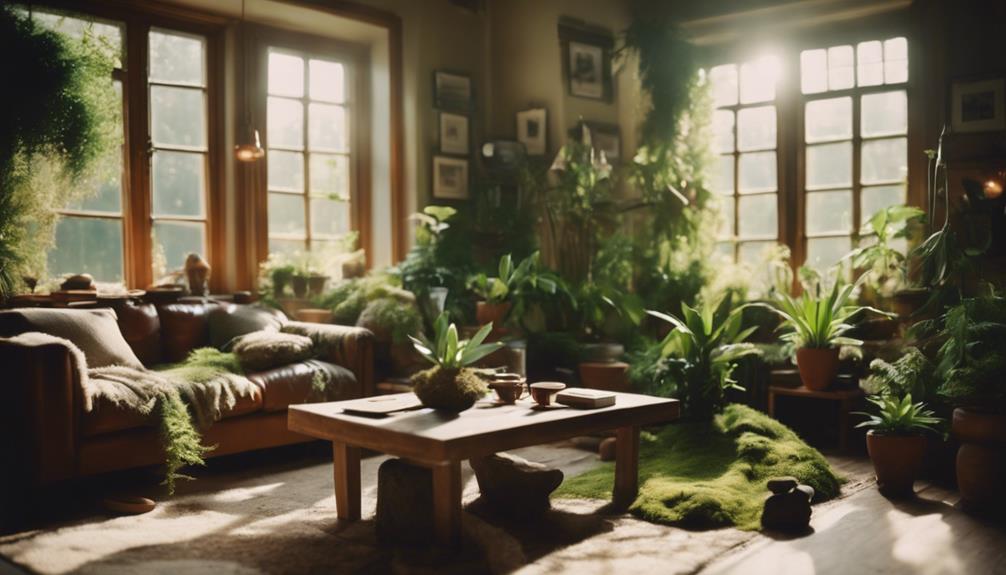To add handmade crafts to your country home decor, focus on warm, earthy tones and natural materials. Incorporate charming elements like hand-painted ceramic vases or woven wicker baskets for character and texture. Choose handmade lighting options, such as mason jar pendant lights, that enhance the rustic vibe. Don't forget to mix in unique pieces from local artisans, ensuring your decor is both stylish and memorable. Consider accents like burlap runners for your dining table, which create a cozy atmosphere. If you want to explore more ways to elevate your decor, there are plenty of ideas waiting for you.
Key Elements
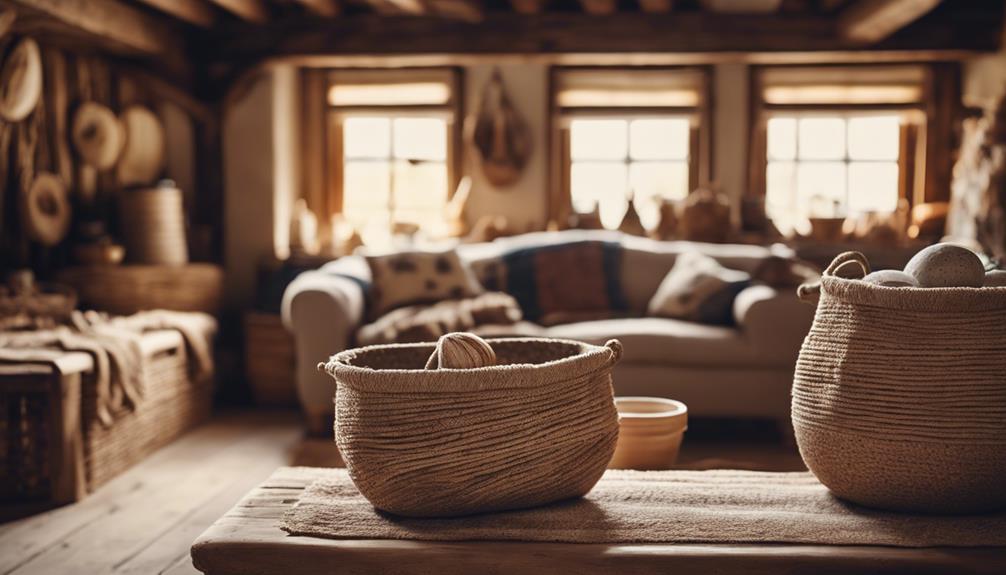
When creating your country home decor, pay attention to the key elements: color scheme, materials, and textures.
Choosing warm, earthy tones can enhance the cozy vibe, while selecting natural materials adds authenticity.
Don't forget to mix different textures to create visual interest and warmth in your space.
Color Scheme
A well-chosen color palette plays an essential role in creating the warm, inviting atmosphere typical of country home decor. To achieve this, consider using warm, earthy tones like browns, greens, and deep reds that reflect rustic charm.
These colors can be complemented by soft neutrals such as cream, beige, and grey, which help balance bolder hues and enhance the cozy feel of your space.
For a touch of brightness, you might add accent colors like mustard yellow or burnt orange, especially in your fall-themed DIY projects.
When you're crafting your country crafts, using a consistent color scheme throughout—like coordinating wall art and textiles—will create a cohesive look in your home.
Materials
Finding the right materials is essential for creating handmade crafts that reflect the charm of country home decor. Start by sourcing reclaimed wood and vintage finds; these elements are perfect for crafting rustic wall art that adds character to your space.
Incorporating burlap is another great idea. Use it to create DIY projects like burlap flowers or rustic table runners, which bring a country chic aesthetic to your home.
Don't forget to check out thrift stores for unique items like milk jugs and cushions. These treasures can inspire creativity and resourcefulness in your handmade decor. Transform dollar store items into creative crafts—think cutting board decor or festive seasonal accents. This approach keeps costs low while allowing you to personalize your decor.
Experiment with fabric sunflowers and other fall decor crafts to introduce warmth and seasonal flair to your home. By choosing the right materials, you'll guarantee your crafts not only look great but also embody the essence of country style.
Textures
Incorporating a variety of textures like burlap, cotton, and reclaimed wood instantly enhances the rustic charm of your country home decor. These materials create a warm and inviting atmosphere, making your space feel lived-in and cozy. Consider adding DIY fabric sunflowers crafted from textured fabrics; they not only add depth to your fall decorations but also maintain that sought-after farmhouse aesthetic.
Don't underestimate the power of vintage finds and weathered materials. They provide a tactile contrast that enriches your decor's layered feel. For instance, a faux fur throw can add an element of softness to your living room, while layered rugs contribute to a cozy ambiance, emphasizing comfort and style.
Mixing and matching textures—like pairing metal accents with rustic wood or soft linens—creates a dynamic visual experience. This eclectic approach reflects the essence of country chic design, allowing you to personalize your space.
Essential Fixtures and Furniture
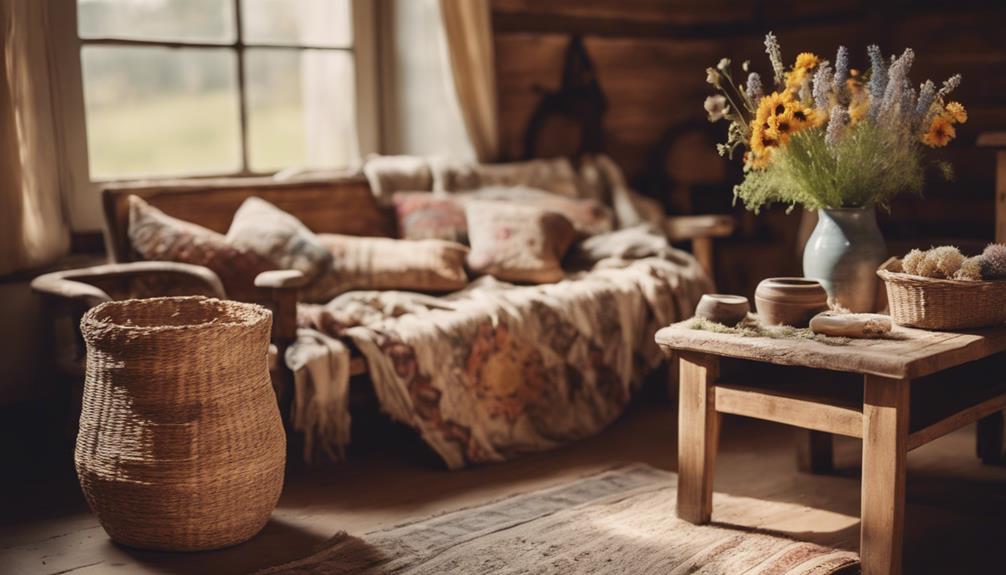
When you think about essential fixtures and furniture for your country home, consider how an antique farmhouse dining table can serve as a stunning centerpiece.
Pair it with a vintage farmhouse sideboard for added storage and charm, while a rustic barn door cabinet can enhance your space with its unique character.
These pieces not only provide functionality but also reflect the warm, inviting style of country decor.
Antique Farmhouse Dining Table
An antique farmhouse dining table becomes the heart of your country home, inviting family and friends to gather around its rustic charm and rich character. Often crafted from reclaimed wood, these tables add a unique touch that enhances your decor. The rustic finish showcases natural imperfections, making each piece truly one-of-a-kind and brimming with history.
Designed to accommodate larger gatherings, an antique farmhouse dining table reflects the communal spirit of country living. It's perfect for holiday feasts or casual get-togethers, where laughter and conversation flow freely.
To elevate the eclectic farmhouse style, consider pairing your table with mismatched dining chairs. This combination not only adds visual interest but also creates a warm, inviting atmosphere.
To accentuate the rustic appeal of your antique table, incorporate handmade elements like a burlap table runner or seasonal centerpieces. These touches can enhance the warmth and character of your dining space, making every meal feel special.
Vintage Farmhouse Sideboard
A vintage farmhouse sideboard complements the antique farmhouse dining table beautifully, providing both storage and style that enhances your country home decor. This multifunctional piece offers the perfect solution for stashing dining essentials, helping you maintain a tidy space while showcasing rustic charm.
When selecting a sideboard, look for options crafted from reclaimed wood. Not only does this emphasize sustainability, but it also adds a unique touch of history to your home. Incorporating metal accents, like wrought iron handles or hinges, further elevates the farmhouse aesthetic while ensuring durability.
To personalize your sideboard, consider decorating the top with vintage kitchen tools, mason jars filled with dried flowers, or a collection of antique dishes. These items inject character and warmth into your dining or living area. If you prefer a more open feel, choose a sideboard with open shelving. This allows you to display decorative items, creating an inviting atmosphere for family and friends.
Incorporating a vintage farmhouse sideboard into your country home decor not only enhances functionality but also serves as a stunning focal point, blending perfectly with your rustic style.
Rustic Barn Door Cabinet
Incorporating a rustic barn door cabinet into your home not only boosts storage but also creates an enchanting centerpiece that embodies the farmhouse aesthetic.
Constructed from reclaimed or barn wood, these cabinets often feature sliding doors that enhance their rustic charm while offering easy access to your stored items.
You'll find that many barn door cabinets come with vintage accents, like metal hardware and distressed finishes, which add to their authentic country style. Their unique designs serve as both functional storage solutions and engaging focal points in any room.
What's great about these cabinets is their customizable options. You can choose the size, finish, and configuration that best fits your space and personal design preferences.
Whether you need extra storage in your living room, dining area, or even a home office, a barn door cabinet can help you organize your living areas effectively.
Lighting Ideas

When you think about lighting for your country home, consider charming options like mason jar pendant lights or vintage lantern wall sconces.
A rustic chandelier with candles adds warmth and character, while antique brass table lamps can bring a touch of elegance to your spaces.
Each of these choices not only illuminates but also enhances your home's cozy, inviting atmosphere.
Charming Mason Jar Pendant Lights
Crafting charming mason jar pendant lights instantly adds a rustic flair to your country home decor while providing practical illumination. These lights aren't just stylish; they're functional too, making them a popular choice for DIY enthusiasts. You can easily create your own pendant lights using mason jars, pendant light kits, and a few basic tools.
Mason jar pendant lights fit perfectly in various spaces, whether it's your kitchen, dining area, or entryway. They enhance the farmhouse aesthetic and bring a warm, inviting glow to your home. For an even cozier feel during evenings and gatherings, consider adding Edison bulbs to your mason jar creations.
Customization is key when it comes to making these lights uniquely yours. You can paint the jars or add decorative elements like twine to match your existing decor style. This versatility guarantees that your pendant lights not only light up your space but also reflect your personal taste.
Vintage Lantern Wall Sconces
Vintage lantern wall sconces bring a cozy, rustic charm to your country home decor, enhancing any space with soft, inviting light. These charming fixtures not only illuminate your home but also serve as stunning decorative elements. Crafted from reclaimed materials like old wood or metal, they align perfectly with the upcycling trends prevalent in farmhouse styling.
You can place these sconces in various locations, whether in your entryway, living room, or even outdoor patios, providing both functional and aesthetic appeal. Many vintage designs showcase intricate detailing and distressed finishes, which complement the overall rustic vibe of your home beautifully.
If you're concerned about safety and energy efficiency, consider using battery-operated or solar-powered lanterns in your wall sconces. These options maintain the vintage look while offering peace of mind.
With their unique charm and versatile placement, vintage lantern wall sconces can transform any area into a warm, welcoming retreat. By incorporating these fixtures into your decor, you'll create an inviting atmosphere that reflects your personal style and love for handmade crafts. So go ahead, brighten up your country home with these delightful sconces!
Rustic Chandelier With Candles
A rustic chandelier with candles instantly elevates the ambiance of your country home, creating a warm and inviting focal point that draws attention. This stunning centerpiece not only adds charm but also enhances the cozy atmosphere you seek.
To align with the farmhouse aesthetic, consider incorporating mason jars or wrought iron elements into your chandelier design. These unique touches can make your lighting fixture truly stand out.
If you're concerned about safety, choosing LED candles can provide an energy-efficient alternative while still delivering that enchanting flicker of traditional candlelight. For added visual interest, hang your chandelier at varying heights; this technique complements rustic decor beautifully and creates a dynamic look.
Additionally, think about using reclaimed wood or distressed materials in your chandelier's construction. This approach not only supports sustainability but also solidifies the rustic theme in your home.
Antique Brass Table Lamps
Incorporating antique brass table lamps into your decor instantly elevates the warmth and elegance of your country home, making them a perfect lighting choice for any room. These lamps offer a timeless appeal that enhances your rustic aesthetic with their warm metallic finish. The intricate designs—like ornate bases and vintage-style shades—complement farmhouse and country chic interiors beautifully.
Placing antique brass table lamps in strategic spots can provide ambient lighting, creating a cozy atmosphere ideal for relaxing evenings or entertaining guests. You'll find that they tie together your space, especially when paired with rustic elements such as reclaimed wood furniture or vintage decor.
A great way to source these unique pieces is through thrift stores or vintage shops. Not only can you snag a stunning lamp at a reasonable price, but you'll also be supporting sustainable practices by giving these treasures a new life in your home.
Decorative Elements
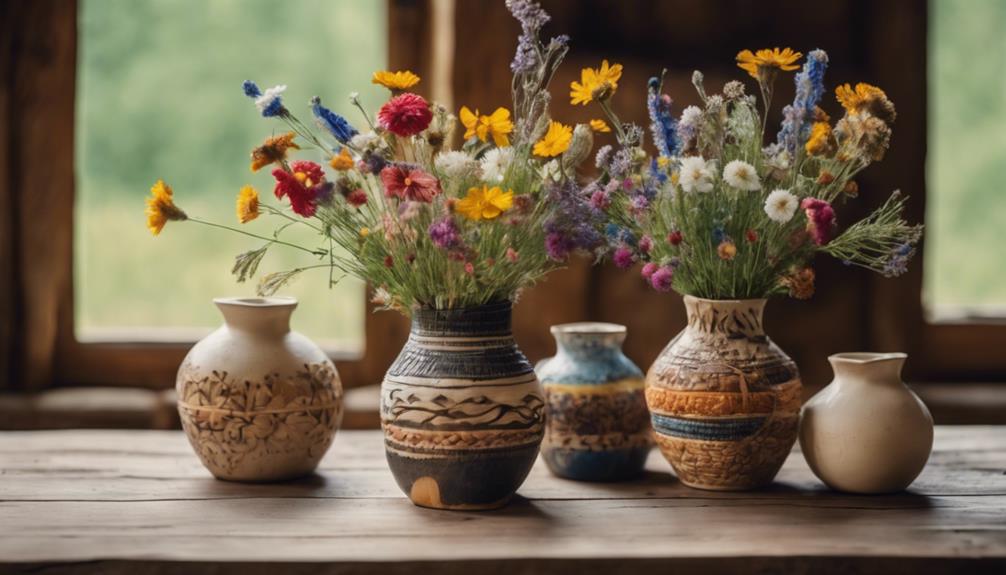
When it comes to decorative elements, hand-painted ceramic vases, woven wicker wall baskets, and quilted fabric wall hangings can really elevate your country home decor.
These unique pieces not only add character but also showcase your personal style.
Let's explore how each of these crafts can bring warmth and charm to your space.
Hand-Painted Ceramic Vases
Hand-painted ceramic vases bring a unique charm to your country home decor, reflecting both artistic craftsmanship and your personal style. These beautiful decorative elements showcase a variety of rustic designs, such as floral patterns or farmhouse motifs, which enhance the overall aesthetic of your space.
You'll find hand-painted ceramic vases in various sizes, making them perfect as statement pieces or subtle accents throughout your home. Whether you decide to fill them with fresh flowers or leave them as standalone decor, they add a touch of warmth and character to any room.
Moreover, when you choose these vases, you're supporting local artisans who often craft them in small batches. This guarantees that each piece is unique and of high quality, making your decor even more special.
Incorporating hand-painted ceramic vases into your country home decor not only elevates your space but also showcases your appreciation for craftsmanship and creativity. So, go ahead and explore the world of hand-painted ceramics; you might just find that perfect piece that speaks to your heart and complements your home beautifully.
Woven Wicker Wall Baskets
Woven wicker wall baskets elevate your country home decor by infusing warmth and texture into your living space. These versatile decorative elements enhance the rustic charm of any room, making them perfect for adding character to your walls.
With various sizes and shapes available, you can create unique arrangements that fit seamlessly into entryways, living rooms, or any corner of your home.
Beyond their aesthetic appeal, wicker wall baskets serve as functional storage solutions, helping you maintain organization while contributing to that inviting farmhouse vibe. You can fill them with seasonal decor, like dried flowers or greenery, allowing your wall baskets to become dynamic focal points that change throughout the year.
To create a cohesive look, pair your wicker baskets with other natural materials such as wood or burlap. This combination enhances the overall rustic theme of your decor, making your country home feel even more inviting.
Quilted Fabric Wall Hangings
Quilted fabric wall hangings add a cozy touch to your country home decor, bringing warmth and personality to any room. These charming pieces offer a unique blend of texture and color, making them perfect for enhancing your farmhouse aesthetic. With a variety of fabrics available, you can create personalized designs that truly reflect your style and preferences.
Incorporating patchwork techniques into your quilting allows you to embrace that rustic vibe, adding charm and character to your walls. Plus, quilted wall hangings can serve as functional art. Consider adding pockets or hooks to hold small items or seasonal decorations, merging beauty with practicality in your space.
This DIY project is accessible to crafters of all skill levels, so you don't need to be an expert to create something beautiful. Whether you choose to hand-stitch or use a sewing machine, you can easily craft a quilted wall hanging that fits your home's decor.
Flooring

When you're choosing flooring for your country home, think about options like reclaimed barn wood planks or distressed painted pine floorboards to capture that rustic vibe.
Cottage-style painted floor tiles can also add a unique touch while enhancing the overall warmth of your space.
Each choice not only reflects country charm but also tells a story that complements your handmade decor.
Reclaimed Barn Wood Planks
Reclaimed barn wood planks bring a sustainable and stylish touch to country home decor, showcasing unique textures and colors shaped by years of weathering. By choosing this flooring option, you're not just adding character and warmth to your space, but also making an environmentally conscious decision.
Reclaimed wood notably reduces the demand for new lumber, helping to combat deforestation and utilize materials that might otherwise end up as waste. Each plank tells a story with distinctive features like nail holes, knots, and varying grain patterns, enhancing your rustic aesthetic.
When properly treated and finished, these planks offer impressive durability, often outlasting traditional flooring options while requiring minimal maintenance. You'll appreciate how easy it's to care for your new floor, allowing you more time to enjoy your beautifully decorated home.
Moreover, installing reclaimed barn wood flooring can increase your home's value, attracting buyers who prioritize eco-friendly choices and stylish design. So, if you're looking to elevate your country home decor, consider the charm and sustainability of reclaimed barn wood planks—they're a choice that benefits both you and the environment.
Distressed Painted Pine Floorboards
Distressed painted pine floorboards add a unique rustic charm to your country home, enhancing the space with their weathered appearance and character. The distressing process involves techniques like sanding, painting, and using tools to mimic the natural aging of wood, giving your floors that sought-after lived-in look.
Pine is a popular choice for flooring because it's affordable, readily available, and takes paint and stains beautifully. You can experiment with a combination of paint colors to create depth and intrigue; lighter hues can showcase the wood grain, while darker shades add richness.
Maintaining your distressed painted pine floorboards is straightforward. Regular cleaning will keep them looking fresh, and periodic refinishing will help preserve their rustic appeal and durability. This makes them not only a stylish option but also a practical one for your home.
Cottage-Style Painted Floor Tiles
Cottage-style painted floor tiles bring a delightful and personalized flair to your country home decor, allowing you to express your unique style through vibrant colors and patterns. You can easily transform your flooring by using chalk paint, which requires just one coat for full coverage—perfect for busy crafters like you.
These tiles can feature charming floral or geometric designs, enhancing the cottage aesthetic and infusing your space with a fresh, lively look. To guarantee precision and prevent smudging while painting, it's crucial to create a clear workspace and use masking tape to outline your designs. This way, you can achieve those crisp, beautiful lines that make a significant difference in the final appearance.
Once you've completed your painted tiles, you'll find they not only beautify your home but also provide a durable finish that withstands everyday wear and tear. This means you can enjoy your stunning new flooring without worrying about damage.
Embrace the opportunity to showcase your creativity and make your country home truly yours with these charming painted floor tiles!
How can Handmade Crafts Enhance the Magical Charm of Witchcore Room Decor?
Elevate your space with enchanting witchcore room decor ideas. Handmade crafts can add a touch of magic to your room, whether it’s a mystical tapestry, whimsical potion bottles, or spellbinding crystal jewelry. These unique pieces bring an authentic and bewitching charm to any witchy-themed room.
Conclusion
By incorporating handmade crafts into your country home decor, you create a space that's uniquely yours.
These personal touches not only enhance the warmth of your home but also tell a story of creativity and tradition.
Whether it's through essential fixtures, cozy lighting, or decorative elements, each piece adds character.
Remember, it's all about blending comfort with charm.
So go ahead, embrace those handmade treasures and watch your country home come alive with style and personality!

